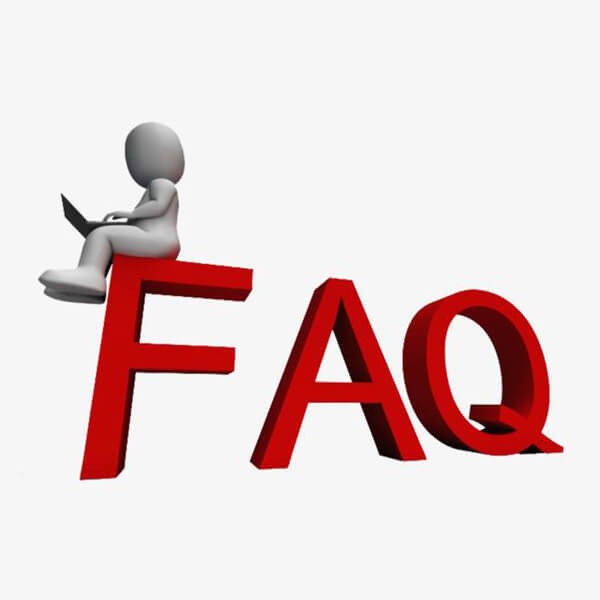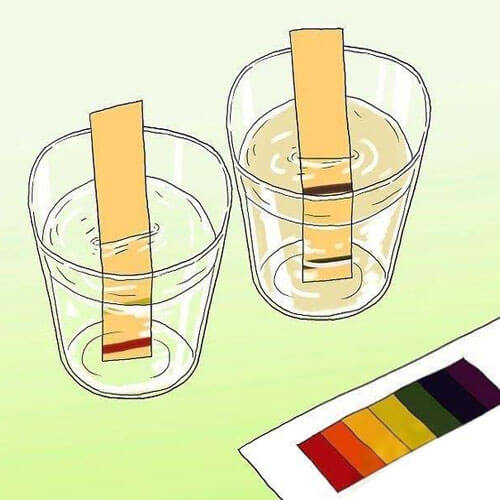Soil moisture is the source of the survival of plants. Soil moisture refers to the moisture content of the soil. The moisture content of the soil directly affects the growth quality and speed of crops. In the planting industry, crops cannot directly obtain the inorganic elements in the soil by themselves. The water in the soil acts as a solvent to dissolve these inorganic elements. The crops absorb soil water through the root system to obtain nutrients and promote growth. Therefore, precipitation or irrigation must be converted into soil. Water can be absorbed by plants. During the process of growing and completing the development of crops, because of the different varieties, the requirements for soil temperature, water content and salinity are also different. There are many ways to monitor soil moisture, and the most commonly used method is to measure it through a soil moisture sensor.
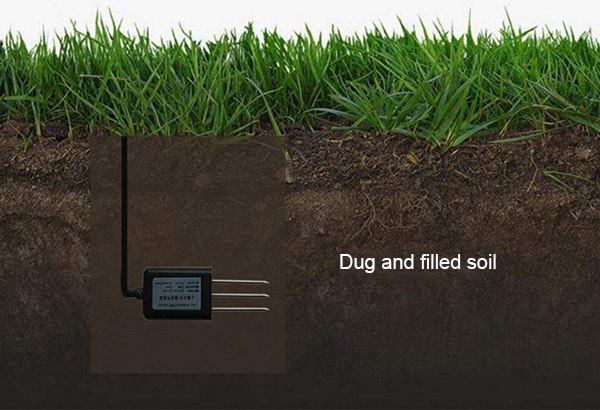
Most people are familiar with soil moisture sensors, but there are many problems when choosing and using soil moisture sensors. Here are some frequently asked questions about soil moisture sensors.
FAQs about Soil Moisture Sensors
1. How soil moisture sensor works?
The most commonly used soil moisture sensors on the market are the tdr soil moisture sensor and fdr soil moisture sensor.
FDR soil moisture sensor working principle
FDR refers to frequency domain reflection, which uses the principle of electromagnetic pulse. The apparent dielectric constant (ε) of the soil is measured according to the frequency of electromagnetic waves propagating in the medium to obtain the soil volumetric water content (θv). The measurement principle, system installation, measurement method and application of FDR system in continuous dynamic monitoring of soil moisture are introduced, and the actual measurement results are corrected, which can be used as a reference for FDR correction.
TDR soil moisture sensor working principle
TDR refers to time domain reflectance, which is a common principle for quickly detecting soil moisture. The principle is that the waveform on a mismatched transmission line will reflect. The waveform at any point on the transmission line is the superposition of the original waveform and the reflected waveform. The response time of TDR principle equipment is about 10-20 seconds, which is suitable for mobile measurement and fixed-point monitoring.
2. What is the output of soil moisture sensor?
- The probe is powered by a 4.5~30V DC power supply, and the output signal is a standard RS485modbus protocol.
- The probe is powered by a 10~30V DC power supply, and the output signal can be 4-20ma, 0-5v, 0-10v.
- The probe is powered by a DC 3.6V lithium battery and can output wirelessly, such as lora output.
3. How to calibrate a soil moisture sensor?
The most reliable way to calibrate any type of sensor is to compare it with a known good-performance instrument under actual humidity conditions. The relative humidity in the range of 50 to 90% is usually found between noon and midnight in summer, and another Methods, such as continuous water spraying in a civil bathroom, can be used in the high-mix range, and the relative humidity below 50% can sometimes be obtained in a central heating chamber, or it can be artificially manufactured indoors with an electric heater. The relative humidity in the room is usually 60% at 20°C. When the temperature is increased to 32°C, the relative humidity can be reduced to 30%. The best instruments for humidity reference are psychrometers and dew point meters. The dew point meter has an accurate calibrated thermometer, which is as accurate as the air temperature measurement, so it will give a reliable humidity value.
4. How to install an automatic soil moisture sensor?
5. How to read a tdr soil moisture sensor?
Our tdr soil moisture sensor has two reading methods: 1. soil moisture sensor data logger, which is convenient for customers to carry and use. We have developed a soil moisture data logger (RS-TRREC-N01-1), which connects the soil moisture sensor to the soil data logger can display soil moisture in real-time. It also has data storage and data export functions. 2. Free cloud platform, for users who have a fixed measurement location and many measurement points can view the data by uploading the data to the free cloud platform provided by our company, which can be viewed in real-time on both computers and mobile phones.
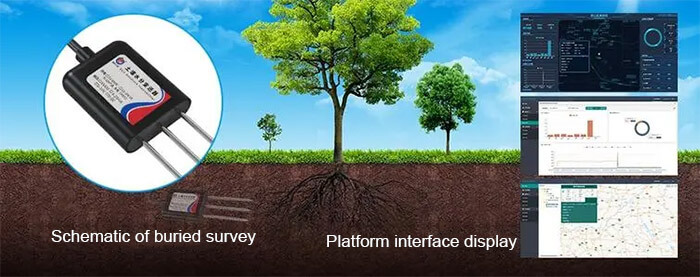
6. Which soil moisture sensor is best?
At present, there are many soil moisture measurement methods on the market, and there are different soil moisture sensors. For example: Time Domain Reflectometry (TDR), Plaster Method, Infrared Remote Sensing Method, Frequency Domain Reflectance Method/Frequency Domain Method (FDR/FD Method), Titration Method, Capacitance Method, Resistance Method, Microwave Method, Neutron Method, Karl Fischer Method, Y-ray method and nuclear magnetic resonance method. The fdr soil moisture sensor and tdr soil moisture sensor are the two most widely used soil sensors with the best accuracy.
7. What does a soil sensor measure?
The soil moisture sensor measures or estimates the amount of water in the soil. According to the relative humidity of the soil, we can know the degree of soil moisture and how much water can be retained, which has reference value in irrigation. Soil moisture affects the field climate, soil aeration and nutrient decomposition, and is one of the important conditions for soil microbial activity and crop growth and development. These sensors can be handheld soil moisture sensor, electronic soil moisture sensor, digital soil sensor, or wireless smart soil sensor. The fixed soil moisture sensor is installed at the measuring point for long-term monitoring, while the portable soil moisture sensor can be moved at will to measure soil moisture in multiple locations.
8. How much area can a soil moisture sensor cover?
It depends on the sensor. Most sensors can cover an area of 1 to 2 acres, and some sensors can cover more. It is indirectly detected from resistance, neutron and dielectric values, and then calibrated according to the scale to find out the moisture content. It also depends on the weather and ambient temperature in the area. The length of the three probes of the standard soil moisture sensor is 7cm, and the best range of the measured humidity is the average humidity of a cylinder with a diameter of 7cm and a height of 7cm (probe length) centered on the middle probe.
9. What type of data can we take from soil moisture sensor?
Common electromagnetic sensors are capacitive sensors or frequency domain reflectance (FDR) sensors and time domain reflectance (TDR) sensors. These sensors indirectly measure VWC based on the dielectric and electrical properties of the soil medium (soil volume permittivity or soil permittivity).
10. How to make soil moisture sensor last longer
1. Vertical insertion of the sensor: Insert the sensor 90 degrees vertically into the soil to be tested. Do not shake the sensor when inserting it to prevent the sensor probe from being bent and damaging the probe.
2. Horizontal insertion of multiple sensors: Insert the sensors into the soil to be tested in parallel. This method is used for multi-layer soil moisture detection. Do not shake the sensor when inserting it to prevent the sensor probe from being bent and damaging the steel needle.
3. When you feel that there are lumps or foreign objects in the tested soil, please reselect the location of the tested soil, or remove the lumps in the current soil, and then continue testing.
4. When storing the soil sensor, wipe the three stainless steel needles clean with dry paper towels, cover them with foam, and store them in a dry environment at 0-60°C.
11. What means depth of soil in soil moisture sensor?
For different soil depths, the water content is different, so the value measured by the soil moisture sensor is also different. The soil moisture sensor can be buried in the soil to measure, so you can choose a suitable soil depth for measurement. It varies according to the type of plant and the texture of the soil. If the tree grows in dry soil or hilly areas, the vertical roots can be as deep as 12 meters. For some vegetables, the roots are about 1 meter deep into the soil. The best water measurement depth for ordinary crops is 5-9 cm.
12. How to measure field capacity with soil moisture sensor?
In recent years, soil moisture sensors have been widely used in automatic irrigation systems. As the monitoring front end of the automatic irrigation system, several sensor measurement points can be set in the field to monitor the field moisture. The user sets instructions to the data collector by logging into the agricultural irrigation platform. When the soil moisture value collected by the collector is lower than the set value, the data collector can send a signal to the controller of the irrigation system to control the opening of the water valve for irrigation. When the soil moisture value collected by the collector is higher than the maximum moisture value set by the user, the collector sends a signal to the controller to control the water valve to close. In this way, the irrigation in the field is automatically controlled. It can not only carry out scientific irrigation but also save water resources.
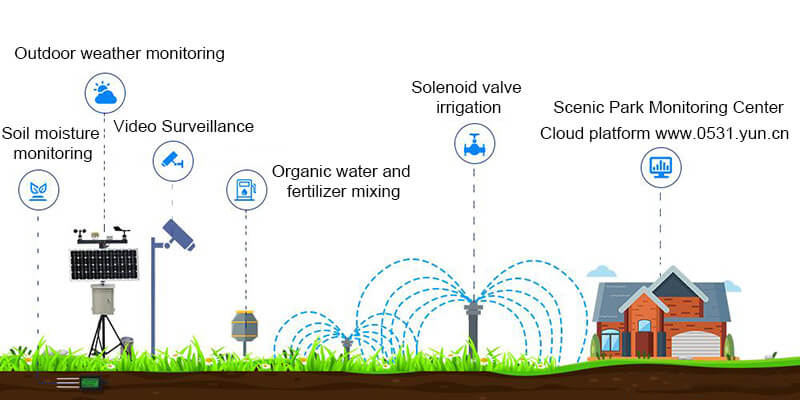
13. How much to install soil moisture sensor?
The installation process of our soil moisture sensor is very simple, no need to ask professionals to install it, saving your labor cost. Generally speaking, the installation cost of the sensor depends on the area of the measurement site and the realization function. Do you need to determine how many soil moisture sensors need to be installed at the measurement location? How many sensors match a data collector? How long is the connection line between the sensors? Do I need to match other controllers to realize certain automatic control functions? After clarifying these issues, you can get accurate spending.
14. How does a soil moisture sensor save resources?
The soil moisture sensor can be directly buried in the soil to measure the moisture content of the root zone. With automatic irrigation system, automatic irrigation can be carried out, saving water resources. You can sit in front of the computer while sipping coffee while controlling the soil moisture content in the garden. The price of the soil moisture sensor is around US$35, with an installation interval of a radius of 20 meters. It can work for more than 3 years under normal environment. Great cost savings. You also don’t need to go to the farm to check the soil conditions in the hot summer or scorching heat.
15. How does a soil moisture sensor prevent saturation?
The principle of the soil moisture sensor is to use two electrodes to measure the electrical resistance in the soil. More water in the soil will reduce the resistance, because current can pass through the water more easily, so avoid immersing the soil moisture sensor in an aqueous solution. The soil moisture sensor measures the water content in the soil, so it cannot be used directly to measure the water content of plant culture solutions.
16. How it works capacitive soil moisture sensor?
Capacitive soil moisture sensor is an instrument commonly used in soil moisture sensors. It uses a high-molecular humidity humidity-sensitive capacitor as the basic humidity sensing element, and uses a single-chip microcomputer to process and remotely transmit the measurement results. It is mainly composed of two parts, a humidity sensitive capacitor and a conversion circuit. Humidity-sensitive material is a high molecular polymer whose dielectric constant changes with the relative humidity of the environment. When the environmental humidity changes, the capacitance of the humidity sensor changes. When the relative humidity increases, the humidity-sensitive capacitance also increases, and vice versa (the capacitance is usually between 48 and 56 pf). The sensor’s conversion circuit converts the humidity-sensitive capacitance change into a voltage change, which corresponds to a change in relative humidity from 0 to 100% RH, and the output of the sensor changes linearly from 0 to 1v.
17. How to choose the best soil moisture sensor device?
1. The soil moisture sensor is often used outdoors, so strict manufacturing processes should be used to conduct waterproof and dustproof treatment on the entire body to ensure stable monitoring of components. The protection level is IP68 to ensure that the body is waterproof and anticorrosive.
2. The sensor needs to insert the probe into the soil for measurement, so the requirements for the probe are also very high. Like the austenitic 316 stainless steel probe, it is rust-proof, non-electrolytic, resistant to salt and alkali corrosion, and is suitable for various soils.
3. The sensor chip is very important for data processing, so pay attention to the type of sensor chip. MCU’s high-quality operational amplifier ensures low power consumption, high sensitivity, and stable signal transmission of the sensor.
4. Airtight performance. High-density epoxy resin vacuum irrigation is used between the probe and the body to prevent moisture from entering the body to a large extent, and the sensor has high airtight performance.
5. In the long-term observation, the measured value after irrigation or rainfall is closer to the true level. If you are performing a quick test, you can water the soil to be tested first, and perform the measurement after the water is fully penetrated. If you are measuring on a hard surface, you should first drill a hole (the hole diameter should be smaller than the probe diameter), then insert it into the soil and compact the soil before measuring.
6. There are many types of soil sensors, and the best way to choose is according to your needs. For example: if you just want to simply measure the soil moisture of crops, then you can choose the cheapest soil moisture sensor. If you want to measure the temperature and moisture values of different soil depths, you can choose a multi-layer soil sensor or multi-depth soil sensor. If you monitor the soil nutrients in the orchard, you can choose a soil NPK sensor or a 7 in 1 soil sensor. If you want to measure the pH of the soil, you can choose a soil pH sensor. If you are a professional gardener, you can choose a soil moisture sensor data logger. In addition, there are some other soil sensor equipment, such as soil tensiometer, soil NPK tester and so on.
18. How to maintain the soil moisture sensor?
About soil moisture sensor maintenance:
- 1. When using the soil moisture sensor, the stainless steel probe must be fully inserted into the soil, avoid rocks, and do not damage the steel needle.
- 2. The housing of the sensor is potted with black epoxy resin, so try to avoid damage to the housing caused by high temperature or direct sunlight. Pay attention to lightning protection when using in the field.
- 3. Do not drop or violently hit the sensor and probe during installation or storage. Do not expose the signal wire of the sensor in a place with high temperature or high humidity.
- 4. After using the soil moisture sensor, wipe the soil and moisture on the probe clean.
19. How to build soil moisture sensor?
Video from Dr SimpleHack by Youtube

